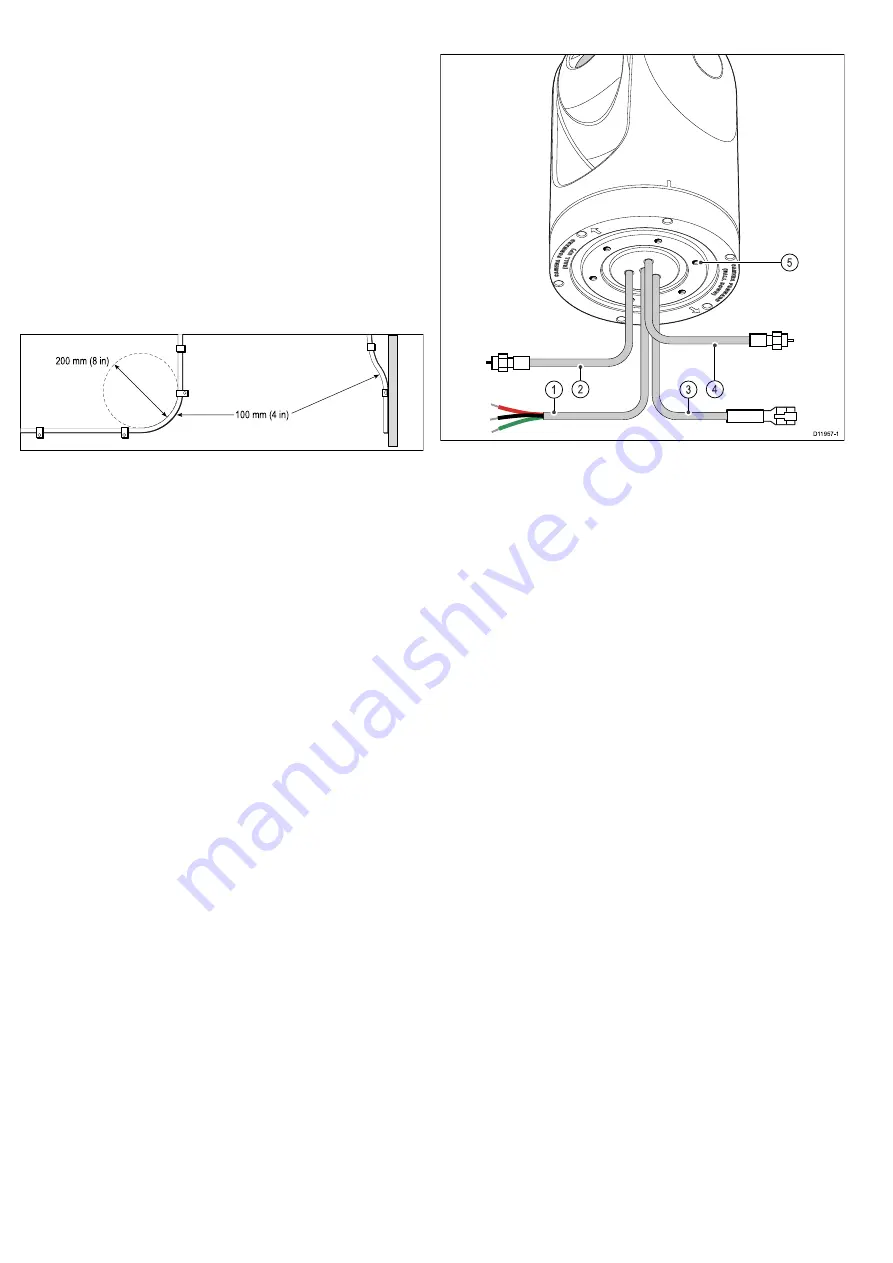
4.1 General cabling guidance
Cable types and length
It is important to use cables of the appropriate type and length
• Unless otherwise stated use only standard cables of the correct
type, supplied by Raymarine.
• Ensure that any non-Raymarine cables are of the correct quality
and gauge. For example, longer power cable runs may require
larger wire gauges to minimize voltage drop along the run.
Routing cables
Cables must be routed correctly, to maximize performance and
prolong cable life.
• Do NOT bend cables excessively. Wherever possible, ensure a
minimum bend diameter of 200 mm (8 in) / minimum bend radius
of 100 mm (4 in).
100 mm (4 in)
200 mm (8 in)
• Protect all cables from physical damage and exposure to heat.
Use trunking or conduit where possible. Do NOT run cables
through bilges or doorways, or close to moving or hot objects.
• Secure cables in place using tie-wraps or lacing twine. Coil any
extra cable and tie it out of the way.
• Where a cable passes through an exposed bulkhead or deckhead,
use a suitable watertight feed-through.
• Do NOT run cables near to engines or fluorescent lights.
Always route data cables as far away as possible from:
• other equipment and cables,
• high current carrying ac and dc power lines,
• antennae.
Strain relief
Ensure adequate strain relief is provided. Protect connectors from
strain and ensure they will not pull out under extreme sea conditions.
Circuit isolation
Appropriate circuit isolation is required for installations using both
AC and DC current:
• Always use isolating transformers or a separate power-inverter
to run PC’s, processors, displays and other sensitive electronic
instruments or devices.
• Always use an isolating transformer with Weather FAX audio
cables.
• Always use an isolated power supply when using a 3rd party
audio amplifier.
• Always use an RS232/NMEA converter with optical isolation on
the signal lines.
• Always make sure that PC’s or other sensitive electronic devices
have a dedicated power circuit.
Cable shielding
Ensure that all data cables are properly shielded that the cable
shielding is intact (e.g. hasn’t been scraped off by being squeezed
through a tight area).
4.2 Connection overview
D11957-1
2
1
4
3
5
1.
Power and drain
2.
IR out – Thermal camera video
3.
SeaTalk
hs
– To Raymarine network switch or JCU
4.
VIS / IR out – Visible light and thermal video. (Dual payload
only, VIS / IR are switched using camera controls.)
5.
Low impedance ground connection
Connection care points:
• You must provide a low impedance chassis to ground connection,
this is made to any one of the chassis threaded fixing points and
is in addition to the drain-to-ground connection.
• The 450 mm (18in) cable tails should be routed to a dry area of
the vessel for connection. Alternatively you must ensure that all
connections are made water tight.
• Ensure that the VIS/IR feed is connected on dual payload models.
Without this connection the user will not be able to use the
camera controllers to switch between the thermal and low light
(visible) camera images.
Thermal camera cables
Cabling requirements for thermal cameras.
Camera to network switch
A network patch cable is required to connect the camera to the
network switch. The connection is made between the camera
cable tail and the network switch via the coupler (supplied with the
camera). Network patch cables are available in a variety of lengths.
Joystick Control Unit (JCU)
An Ethernet (with power) cable is used to connect the JCU. The JCU
is supplied with a 7.62 m (25 ft) Ethernet cable for this connection. If
you require a different length contact your dealer for suitable cables.
Power over Ethernet (PoE) injector to network switch
A network patch cable is required for connecting the PoE injector
to the network switch. Network patch cables are available in a
variety of lengths.
Video cables
Video cables are not supplied with the product. Please contact your
dealer for suitable cables and adaptors.
Raymarine recommends the use of a BNC terminated RG59 75ohm
(or better) coaxial cable.
20
T-Series
Summary of Contents for T303
Page 2: ......
Page 4: ......
Page 6: ...6 T Series...
Page 18: ...18 T Series...
Page 24: ...24 T Series...
Page 28: ...Thin panel mounting D11989 1 Thick panel mounting D11990 1 28 T Series...
Page 40: ...40 T Series...
Page 43: ......
Page 44: ...www raymarine com...
















































